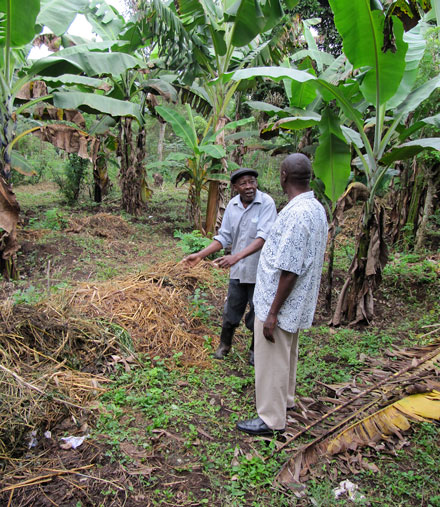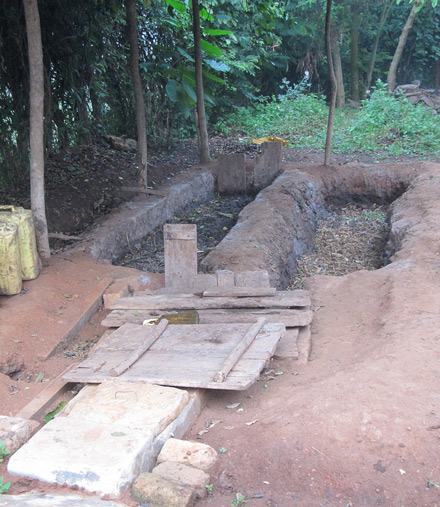Editor's note: This is the second in a ongoing series on biogas.
The first tale of how magical manure transformed Deborah’s kitchen hopefully provided a good visual comparison of her kitchen before and after the introduction of biogas. Now let’s take a step back to see how biogas is produced—how the “magic” happens. Edward is the “wizard” in this tale, and we'll follow him from where biogas begins (the cow), to mixing the “magical” concoction that goes into the biogas “plant,” and then on to the end product. Perhaps we should say end “products” because concentrated fertilizer is also created, which increases garden production and also leads to income generation!

Edward is 71, which in itself is a feat, as the average lifespan in Uganda is 58. It's important to note that the younger generation, as in the U.S., is less interested in farming, even though agriculture is the main source of income for 82 percent of the population. Edward is teaching a young man working on his small farm about how farming is not only a good source of income but an honorable way of living. He passes on his gifts of knowledge and training to those around him, including the importance of manure. Here you see him talking about his banana plants and how trench composting, in addition to applying bioslurry, increases the size and number of bananas he harvests each year.
For those who are visual learners, please watch the video of how manure is collected, mixed and transformed into a magical commodity. It all starts with a cow or a pig whose manure is collected and carried to the mixing chamber, which is the starting point of the biogas plant. Because the cows are fed grasses—no corn feed needed—the manure has almost no odor, and hence attracts hardly any flies. The manure is then hand-mixed with water until it's the consistency of porridge. At which point, a plug at the bottom of the mixing chamber is removed, allowing the mixture to slide into the biodigester, which is the second part of the biogas plant.
The biogas plant is comprised of the mixing chamber, digester, expansion chamber, and composting pits. The design of this biogas plant (as seen in the photos and video) is called a fixed dome digester. The digester is almost completely underground, except for the gas line at the top of the biodigester, which is where the biogas (methane) comes out through a hose flowing to the house. Here, the manure decomposes through an anaerobic process that releases the methane, and then slowly slides from the digester into the expansion chamber. The manure has been converted into a concentrated fertilizer known as bioslurry. The bioslurry slowly moves out of the expansion chamber, through the troughs at the rear opening, and gathers into composting pits.
As one composting pit slowly fills with bioslurry, other biodegradable materials, including leaves and ash, are periodically placed on

top to aid in drying. Once the pit is full, its trough is blocked and another pit is opened to allow the same process. When the material in the composting pit dries, it can be shoveled out, bagged and then sold as compost, which generates income. Additionally, it can be used on the family fields or gardens.
The bioslurry can also be dipped out from the expansion chamber (just before the pits), mixed with water, and applied in its liquid form around the bases of plants. The application has to be done in a very particular way to have the largest increase in crop yields and so it doesn't burn or harm the plants. The bioslurry is as good as gold to these families, as this concentrated organic fertilizer can more than double the yield from their existing land in the second year. For example, the matoke (green banana) fingers are larger and the bunches have more fingers, which really means more income from the same tree than the previous year.
As a special note: another “magical” use of bioslurry is as a feed supplement for chickens and pigs. There will be more on this in a later posting. This is a fascinating look at how bioslurry provides a source of nutrition that chickens and pigs need to thrive.
From this second tale, we’ve added to the growing list of uses for manure:
The next post in the Magical Manure series will show how “intercropping” works to maximize the space small holder farmers have to grow food, as well as how bioslurry works it magic in the fields to increase yields for farmers by more than 100 percent.
For more on biogas, like learning how to build your own biogas generator, go here.
